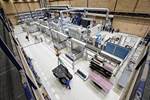Aerospace supply chain partnerships: Offsets vs. opportunities
Although many international aerospace production programs involve offsets, CW contributing writer learned from Steve Over, Lockheed Martin’s (Bethesda, MD, US) director of F-35 international business development, that there are no offsets with any of the countries that hold confirmed purchase orders for the F-35.
Steve Over, Lockheed Martin’s (Bethesda, MD, US) director of F-35 international business development, says a program of the F-35’s magnitude is contingent upon the development of successful working partnerships between aerospace suppliers that are traditionally accustomed to life as competitors. Over is responsible for all of the company’s engagements with Terma Aerostructures (Grenaa, Denmark) and its other international partners as well as the foreign military sales (FMS) countries that will be procuring and operating the aircraft. “It starts off, first, at the government-to-government level,” he says, “because the F-35 is a tool of US foreign policy, and developing stronger relationships with all these international partners around the world.”
Many international production programs involve offsets — direct and indirect. Direct offsets involve production of equipment that is installed on the airplane weapons system, and indirect offsets involve anything that stimulates the participating country’s economy and, usually, not related to the purchase of that weapon system.
However, Over says there are no offsets with any of the countries that hold confirmed purchase orders for the F-35 right now. Instead, industrial participants in the countries that are buying the airplane have been given an opportunity to participate in the F-35’s global supply chain. Those in Denmark had such an opportunity.
“Terma is a perfect example,” Over points out. “They had to compete against US and other countries’ providers of equipment. In each of these competitions, the selection was based on a cost/value basis, meaning that they were able to demonstrate that their prices and the equipment they operate or parts they provide offer the best value to the overall F-35 supply chain.
“Most of the time, when we talk about offsets, they are related to that specific country’s purchase,” Over explains. “For those countries whose industries are participating in the F-35, their industries are having an opportunity to supply parts for the entire program of record — so more than 3,100 airplanes that will be purchased.”
The catch is that a part’s supplier must continue to maintain that part’s “best value” status throughout the life of the program. “So it’s not a birthright,” Over notes, “but as long as they are doing what they need to help us bring the price of the airplane down and maintain competitive pricing, there is no reason those companies won’t be supplying that part for the 3,100-aircraft program of record.”
This short article is a Side Story to a CW Plant Tour titled, "Terma Aerostructures: Grenaa, Denmark." To read the Plant Tour feature article, click on it's title under "Editor's Picks" at top right.
Related Content
-
Plant tour: Joby Aviation, Marina, Calif., U.S.
As the advanced air mobility market begins to take shape, market leader Joby Aviation works to industrialize composites manufacturing for its first-generation, composites-intensive, all-electric air taxi.
-
Plant tour: Spirit AeroSystems, Belfast, Northern Ireland, U.K.
Purpose-built facility employs resin transfer infusion (RTI) and assembly technology to manufacture today’s composite A220 wings, and prepares for future new programs and production ramp-ups.
-
Carbon fiber in pressure vessels for hydrogen
The emerging H2 economy drives tank development for aircraft, ships and gas transport.













